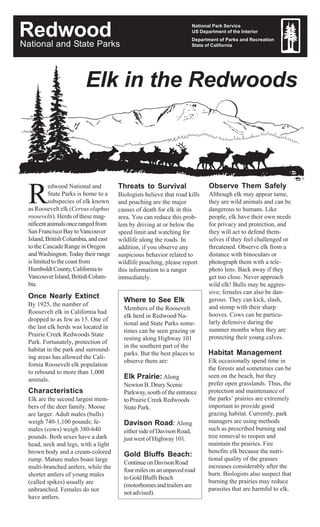
Elk in the Redwoods National and State Parks
- 1. Redwood National Park Service US Department of the Interior Department of Parks and Recreation State of CaliforniaNational and State Parks R edwood National and State Parks is home to a subspecies of elk known as Roosevelt elk (Cervus elaphus roosevelti). Herds of these mag- nificentanimalsoncerangedfrom San Francisco Bay toVancouver Island,BritishColumbia,andeast to the Cascade Range in Oregon andWashington.Todaytheirrange islimitedtothecoastfrom HumboldtCounty,Californiato VancouverIsland,BritishColum- bia. Once Nearly Extinct By 1925, the number of Roosevelt elk in California had dropped to as few as 15. One of the last elk herds was located in Prairie Creek Redwoods State Park. Fortunately, protection of habitat in the park and surround- ing areas has allowed the Cali- fornia Roosevelt elk population to rebound to more than 1,000 animals. Characteristics Elk are the second largest mem- bers of the deer family. Moose are larger. Adult males (bulls) weigh 740-1,100 pounds; fe- males (cows) weigh 380-640 pounds. Both sexes have a dark head, neck and legs, with a light brown body and a cream-colored rump. Mature males boast large multi-branched antlers, while the shorter antlers of young males (called spikes) usually are unbranched. Females do not have antlers. Where to See Elk Members of the Roosevelt elk herd in Redwood Na- tional and State Parks some- times can be seen grazing or resting along Highway 101 in the southern part of the parks. But the best places to observe them are: Elk Prairie: Along Newton B. Drury Scenic Parkway, south of the entrance to Prairie Creek Redwoods State Park. Davison Road: Along either side of Davison Road, just west of Highway 101. Gold Bluffs Beach: ContinueonDavisonRoad four miles on an unpaved road toGoldBluffsBeach (motorhomesandtrailersare notadvised). Observe Them Safely Although elk may appear tame, they are wild animals and can be dangerous to humans. Like people, elk have their own needs for privacy and protection, and they will act to defend them- selves if they feel challenged or threatened. Observe elk from a distance with binoculars or photograph them with a tele- photo lens. Back away if they get too close. Never approach wild elk! Bulls may be aggres- sive; females can also be dan- gerous. They can kick, slash, and stomp with their sharp hooves. Cows can be particu- larly defensive during the summer months when they are protecting their young calves. Habitat Management Elk occasionally spend time in the forests and sometimes can be seen on the beach, but they prefer open grasslands. Thus, the protection and maintenance of the parks’ prairies are extremely important to provide good grazing habitat. Currently, park managers are using methods such as prescribed burning and tree removal to reopen and maintain the prairies. Fire benefits elk because the nutri- tional quality of the grasses increases considerably after the burn. Biologists also suspect that burning the prairies may reduce parasites that are harmful to elk. Threats to Survival Biologists believe that road kills and poaching are the major causes of death for elk in this area. You can reduce this prob- lem by driving at or below the speed limit and watching for wildlife along the roads. In addition, if you observe any suspicious behavior related to wildlife poaching, please report this information to a ranger immediately. Elk in the Redwoods
- 2. The Elk Calendar Seasonal changes mark the behavior of elk herds, as they have since long before humans were around to observe them. Autumn The breeding or rutting period occupies elk from late August to mid-October. This is when bull elk compete for control of groups of females, called “har- ems.” To attract mates and warn away other bulls, mature male elk make a bellowing, whistling sound called bugling. Bugling, pit wallowing, and antler clash- ing all are preludes to combative contacts between pairs of rival bulls. A challenger may ap- proach a harem bull, bugling, urinating, and tossing turf with his antlers. The harem bull likely will advance and bugle. The pair may circle and one may charge. If the other holds his ground, the resulting clash of antlers may wound or even kill an elk, but before this happens one of the bulls usually admits defeat and retreats. Winter Due to the mild climate of the Northern California coast, elk in this area do not need to migrate although they do grow a second insulating layer of warm fur. Even with our mild climate, the limited amount of new plant growth available for food makes this a stressful time of year for elk. Spring In February and March, males shed their antlers. About a week later they begin to grow new ones at the rate of 10 to 12 inches per month. Their growing antlers, formed from keratin, a bone-like material, are nourished by blood vessels in a soft mem- brane covering called “velvet.” Scentless calves, born in May and June, remain hidden from predators for the first week or two while their mothers graze a short distance away. Later, cows and calves join the herd of females and young males, which is led by an older cow. Older males form separate bachelor herds or remain solitary through the summer. Summer By late August the bull elk’s antlers stop growing. The blood vessels inside the velvet dry up, causing it to fall off. Bulls often rub their antlers on trees and bushes to remove the dried velvet. Soon the rutting season begins and the ancient cycle continues. Published by Redwood Park Association in cooperation with Redwood National and State Parks, National Park Service 2004. EXPERIENCE YOURAMERICA revised 9/02